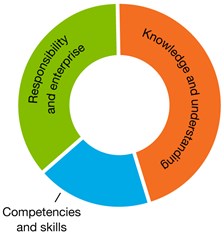Explore content
7-10 Economics and Business
The Australian Curriculum: Economics and Business is uniquely positioned to develop consumer and financial literacy in young people. The curriculum supports the development of the dimensions of consumer and financial literacy as shown in the diagram below.

Approximate proportion of the dimensions addressed in 7-10 Economics and Business
Consumer and financial literacy is one of the key organising ideas of this subject. Students learn about the importance of financial planning, the rights and responsibilities of consumers and businesses, how people manage financial risks and rewards, the factors that influence major consumer decisions and the short- and long-term effects of those decisions. Students have opportunities to explore laws, regulations, rights and responsibilities associated with work and work futures, including the role and purpose of tax and superannuation. Economics and Business also introduces students to the structure and management of the economy and its resources and the issues and challenges of global economic interdependence. Developing an understanding of fundamental economic and business concepts enables young people to be informed decision-makers, responsible consumers and financially confident citizens.
The study of Economics and Business also supports the development of competencies and skills that can be applied in real-world consumer and financial contexts. For example, the ability to analyse data, explain cause and effect relationships, make predictions and communicate reasoned arguments enables students to make informed choices when purchasing goods and services, deciding on investment options and identifying the differences between ‘good’ and ‘bad’ debt.
In Economics and Business, students develop enterprising skills through investigations and creative activities such as fundraising events or business ventures. Making decisions based on an assessment of the costs and benefits of alternative choices prepares students to apply informed and assertive decision-making in a range of real-world contexts. By exploring the intended and unintended consequences of their decisions, students are also equipped with the skills to reflect on the appropriateness of their initiatives.
The Moneysmart for teachers and Tax, Super and You resources provide a number of interdisciplinary units that either focus on or include aspects of the Economics and Business curriculum. Access a list of relevant resources linked to the Australian Curriculum: Economics and Business using the right-hand menu.
Year 7 Should I drink bottled water?
Year 7 How can we reduce our spending?
Year 8 How can we access money overseas?
Years 5-8 Digital activity – Mobile phone security
Years 7-8 Digital activity – Advertising
Years 7-8 Digital activity – Premium services
Years 7-8 Digital activity – Social media
Years 7-8 Digital activity – Consumer rights
Years 8-9 MilbaDjunga SmartMoney – Secondary unit
Year 9 How can we obtain more money?
Year 9 English – smart consumers 4 a smart future – Smart arguments
Year 9 Mathematics – smart consumers 4 a smart future – Solar sums
Year 9 Science – smart consumers 4 a smart future – My eco-kitchen rules
Year 9 Digital activity – Savvy solutions to consuming questions
Years 9-10 – MoneySmart Rookie – First car
Years 9-10 – MoneySmart Rookie – Credit and debt
Years 9-10 – MoneySmart Rookie – Mobile phone ownership
Years 9-10 – MoneySmart Rookie – Moving out of home
Years 9-10 – MoneySmart Rookie – Online financial transactions
Years 9-10 – MoneySmart Rookie – First job
Years 9-10 Digital activity – Shopping for a mobile
Years 9-10 Digital activity – Online shopping and banking
Year 10 Reaching goals: What’s involved?
Year 10 English – smart consumers 4 a smart future – Green house rules
Year 10 Mathematics – smart consumers 4 a smart future – Money matters
Year 10 Science – smart consumers 4 a smart future – Decisions by the stars
Years 7-10 - Tax 101: Activity 1 – What is tax and why do we need it?
Years 7-10 Tax 101: Activity 2 – Tax: Who, what, how and why
Years 7-10 Tax 101: Activity 3 – How is tax revenue spent?
Years 7-10 Tax 101: Activity 4 – The Budget: taxes and spending
Years 7-10 Tax 101: Activity 5 – History of tax in Australia
Years 7-10 Tax 101: Activity 6 – Role of the ATO
Years 7-10 Your Tax: Activity 1 – Income and income tax
Years 7-10 Your Tax: Activity 2 – Working and paying tax
Years 7-10 Your Tax: Activity 3 – Completing your tax return
Years 7-10 Your Tax: Activity 4 – Calculating tax due
Years 7-10 Your Tax: Activity 5 – What other taxes do I have to pay?
Years 7-10 Your Tax: Activity 6 – Fixing a tax problem
Years 7-10 Business Tax: Activity 1 – What is a business?
Years 7-10 Business Tax: Activity 2 – Business structures
Years 7-10 Business Tax: Activity 3 – Running a business: tax obligations
Years 7-10 Business Tax: Activity 4 – Explaining business taxes
Years 7-10 Business Tax: Activity 5 – The goods and services tax (GST)
Years 7-10 Business Tax: Activity 6 –How is business tax collected?
Years 7-10 Super: Activity 1 – What is superannuation?
Years 7-10 Super: Activity 2 – Where does super money come from?
Years 7-10 Super: Activity 3 – What do I need to do about super?
Years 7-10 Super: Activity 4 – How do I choose a super fund?
Years 7-10 Super: Activity 5 – Super, the ATO and you
Years 7-10 Interactive: The story of tax
Years 7-10 Interactive: Shaping the system
Years 7-10 Interactive: Tax in your community
Years 7-10 Interactive: You make the decision

